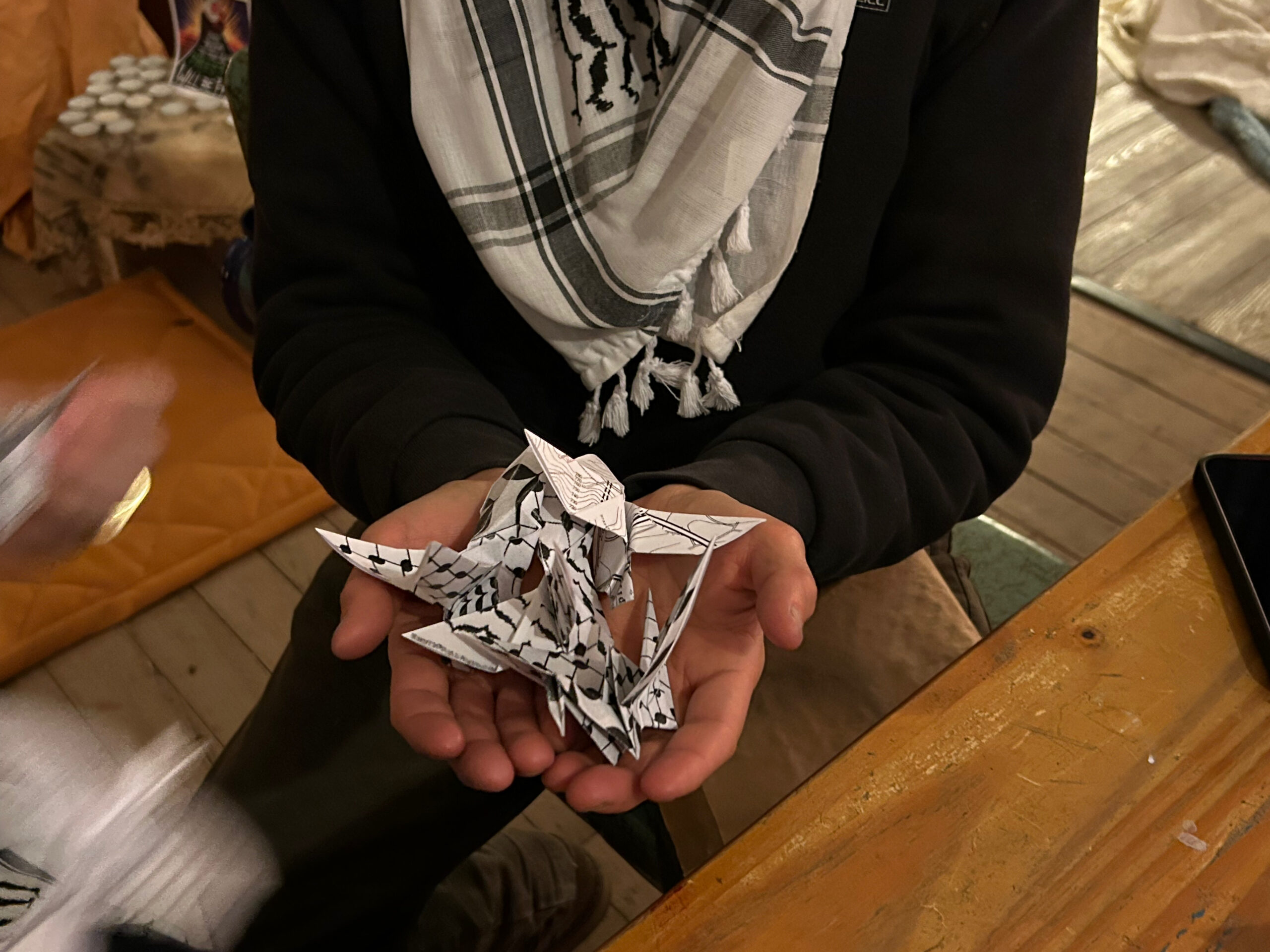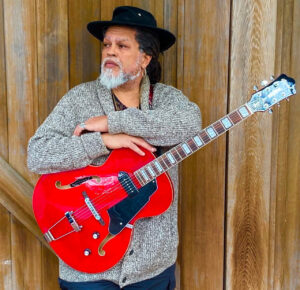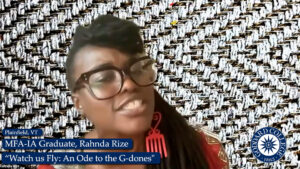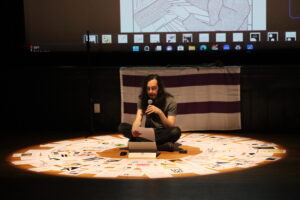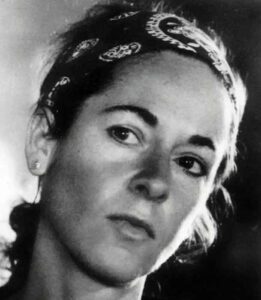
Chad Amos Self, is a Goddard student in the MFA in Interdisciplinary Arts program. He is a sculpture artist living in Rhode Island and is the Vice President of Hera Gallery, an art gallery who’s mission statement includes a dedication “to gender equity and feminist discourse to challenge perceptions and inspire social change.”
Chad was interviewed in April 2021 by Ben t. Matchstick, digital media coordinator for Goddard College, about his upbringing, student life, and his aspirations post-graduation.
Would you be willing to share personal memories of your “untraditional” family and how that influenced you to be an artist?
I grew up in a household of women. My mom, her partner, my younger sister and me. I was mostly raised by my single, lesbian mom. She is a rad lady with a lot of character, a lot of tattoos, and a lot of grit. She always gave me the space, support and time to be a creative person. I could paint all over my bedroom walls (which I did), spend my free time drawing monsters (which I did), and dancing in the living room to the Mortal Kombat soundtrack (which I did). I never played sports or participated in traditional activities and that was ok. My mom would watch me and my friends skateboard like it was a sports game and she always allowed me space to be weird.
You are forward in your recognition for the women mentors in your life. Do you consider yourself a feminist?
I would respectfully and considerately call myself a feminist. I am a supporter of gender equality, I am an observer and learner first, I ask questions instead of providing answers, I adapt and evolve and stay fluid, and I make space for listening instead of telling.
I am in a support role at Hera Gallery, the 5th oldest women’s cooperative gallery in the United States, and I am profoundly happy to be in a position to help Hera continue to provide an alternative exhibition space for southern Rhode Island. The women of Hera Gallery, past and present, are major influences on my life and my art.
How do you feel when you started your residency at Goddard?
Once I started that first residency, I thought: yeah these are my people.
I met 9 other people who were all in the same space. Some of them educators, some of them grinding, some of them trying to find their place as an artist, a musician, a dancer. We are all looking at each other, thinking, oh, we’ve been friends for years.
I feel fortunate but I think many other people have that same story getting into Goddard.

Did you get the same feeling from the shift to virtual residency during COVID?
A lot of programs were greatly affected by COVID and the lockdowns. We lost in-person residencies, but I get the same feeling from the virtual residencies. I think collectively we’re all in the boat.
If you were going to pick a program, (for the pandemic) this was the perfect program to pick.
How did you decide to enroll in this program at Goddard?
Like many artists, I worked in a kitchen for a very long time after my undergrad. Grinding, working, trying to maintain my studio practice. I kept seeing my peers drop their studio practice. I wanted to take myself and my work seriously. Going to grad school felt like one of the areas I needed to improve. I knew eventually grad school would be part of my path.
I always say to people: gather and get as much education as you can with the time that you’ve got.
How did Goddard’s progressive education model surprise you?
Progressive education was something I never encountered in my life.
I was used to the more standardized education, so it took a bit of time to even comprehend progressive education pedagogy. I would say ‘oh, I can do what I want and what I need to do’, and the advisors would say ‘yeah, that’s how this works.’
Around the fourth semester of the Interdisciplinary Arts program, the students are required to engage in a practicum. The practicum is defined as a piece of work that is new and offers opportunity for broadening perspectives and taking your theories of making work in the world. What was your practicum?
Education was something I wanted to participate in. I looked at the practicum as an opportunity to pursue this goal.
I got in touch with the University of Rhode Island starting as a teaching assistant and observer in undergrad sculpture classes. I would teach lectures if called upon. By the next semester, and with fortuitous timing, I was invited to teach sculpture there.
That’s great! Have you been able to integrate your Goddard experiences into your teaching?
Working for a university has a lot of structure. But it is interesting to work these progressive education ideas into my classroom. I’m already finding ways to integrate peer learning, this generative education and progressive pedagogy. It’s been fun to find out what we have to teach each other and bring that forward and actually use it.
How has peer learning influenced your Goddard experience?
Peer learning has been vital. Opportunities to collaborate with dancers, painters, other sculptors, – which is a Goddard thing. Normally, in traditional education environments, we would be in separate pockets.
At Goddard, I am in a cohort with this wild group of amazing artists. Playing music, writing poetry, thinking about their process. This is affecting my work and my work affects theirs. When things start to cross over and you are thinking and doing things that you don’t normally come into contact with, you get these amazing results. These opportunities just come about by being a part of this diverse group at Goddard.
How has your Goddard study impacted your work as an artist?
I’m doing things that I would not normally ever do- incorporating movement, video, and sound. I’m still trying to figure out where to put it in my own portfolio. It seems so different from what i normally do. But I’m comfortable in not-knowing. Starting to create these new practices in my studio, That’s different for me.
The work I’ve made in my Goddard study is outside the bounds of my usual work. I don’t know where it fits yet. I’m incorporating things that I would never do- incorporating movement, video and sound. It’s so different, but comfortable now. I’m creating new practices
You’ve mentioned how you’re delving into progressive education theoretical works like Miles Horton and Paolo Friere’s We Make the Road By Walking, and the works of bell hooks and John Dewey. This isn’t required reading at Goddard, but it is very common. You’ve decided it’s important for you to learn more about this pedegogy. Why?
I never expected to run into so much writing about progressive education. But once you’re in the program, you want to be an expert. I want to know as much as I can about it.
There is so much that I want to understand about what is happening.
I got into the program and I’m thinking ‘I’m an object maker’ but now I’m really thinking about education.
What would you say was your “Goddard Moment”?
Before Goddard, I had a voice. But I didn’t know what to say with that voice. So many things that I knew were important are now coming to the front now. I’m thinking alot about social engagement and how to work in a community. I’m looking at environmentalism in my home state of Rhode Island and the coast is so important to us as a resource. Progressive education, social engagement, environmentalism- I’m trying to tell my own story, more as a writer. The writing is reflective of the work. Where the work used to reflect my thoughts, now I’m putting it to paper and directly saying what I’ve been thinking also.
Chad Amos Self continues to explore new mediums as he completes his Goddard degree. Learn more about Chad’s Goddard-inspired explorations at https://www.chadamosself.com/goddard-work
Find out more about Goddard’s MFA in Interdisciplinary Art program, a unique environment of artists from varying backgrounds and disciplines all working toward achieving their own personal and professional goals outlined in a study plan designed by the student themselves. Inquire today at goddard.edu or contact admissions directly at admissions@goddard.edu.

